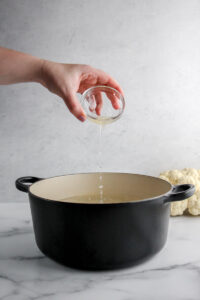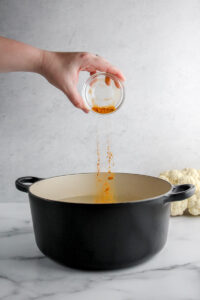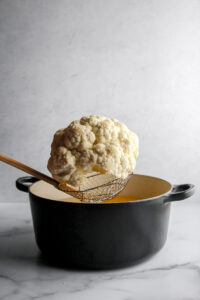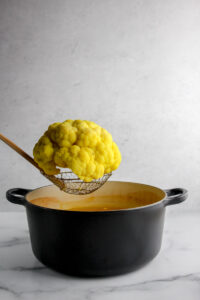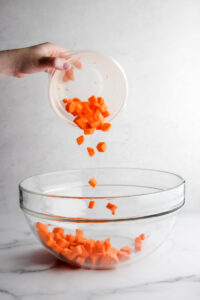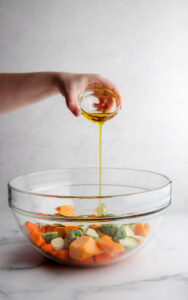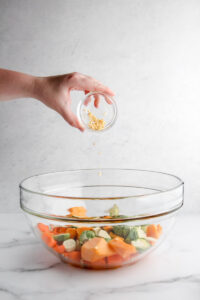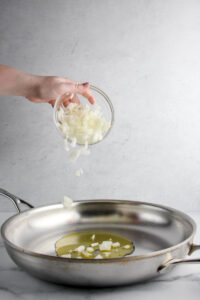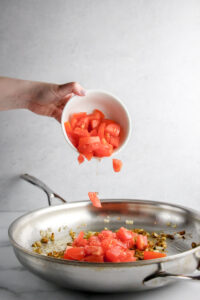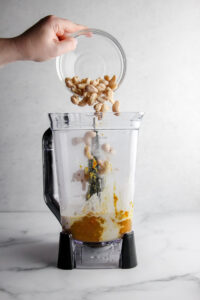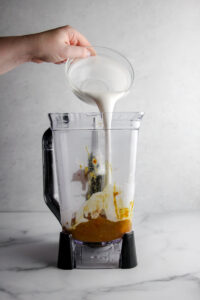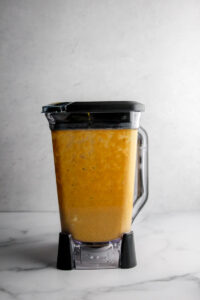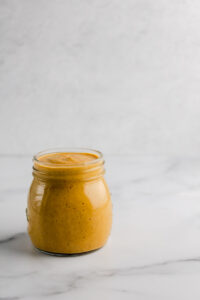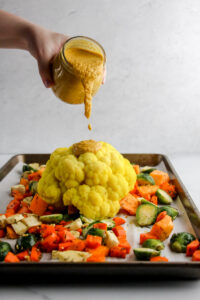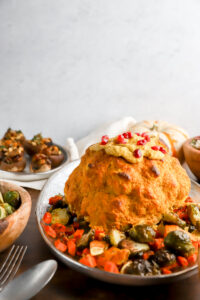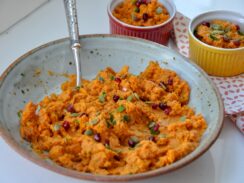Vegan Spiced Roasted Cauliflower
Cauliflower is one of my not-so-secret food loves. Don’t be shocked — cauliflower may seem blank, but it’s actually such a hearty yet porous vegetable that absorbs any flavor you add to it. Over the past few years, cauliflower has started to surface as a clever alternative for starches like potatoes, it has proven itself as a delicious substitute for pizza crusts, pasta, and rice, and it is now the star of my Vegan Spiced Roasted Cauliflower recipe! This dish pairs really well with my Brown Rice Edamame Bowl and my Delicata Squash Green Herb Sauce.
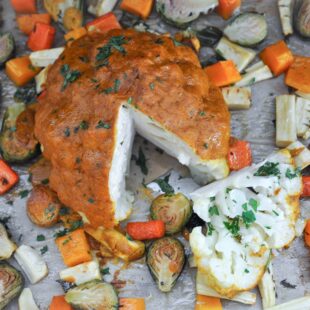
Vegan Spiced Roasted Cauliflower
Ingredients
Cauliflower
- 1 cauliflower head, (washed, leaves and tough stem removed)
- 2 teaspoons salt
- 2 teaspoons lemon juice
- 1/2 teaspoon turmeric
Roasted Vegetables
- 2 cups baby potatoes, (washed)
- 2 cups Brussels sprouts, (washed, halved)
- 2 cups carrots, (cubed)
- 1 parsnip, (cubed)
- 1 cup butternut squash, (cubed)
- 4 whole garlic cloves
- 3 tablespoons fresh thyme leaves
- 3 tablespoons extra virgin olive oil
- Salt and pepper, (to taste)
Sauce
- 2 teaspoons Coconut oil or olive oil
- 1/2 medium onion, (diced)
- 1 inch ginger, (chopped)
- 4 cloves garlic, (chopped)
- 3 strands saffron
- 1 teaspoon garam masala
- 1/2 teaspoon cumin powder
- 1/2 teaspoon coriander powder
- 1/2 teaspoon turmeric powder
- 3 tomatoes, (diced)
- 1 tablespoon dried fenugreek leaves
- 1/4 teaspoon raw sugar, (or 1/2 teaspoon maple syrup)
- 3/4 teaspoon salt
- 3/4 cup coconut milk, (canned)
- 1/3 cup cashews, (soaked)
Instructions
Blanching the Cauliflower
- Wash the cauliflower well, removing any dirt or debris.
- In a large stockpot (big enough to fit a full head of cauliflower!) add water and cauliflower and bring to a boil.
- Add the salt, lemon juice, and turmeric, then cook the cauliflower for 4 minutes on each side, flipping it once.
- Using a slotted spoon or tongs, take the cauliflower out of the pot and submerge it in a big bowl of ice water for about 3 minutes. Drain well and set aside.
Roasting the Vegetables
- Preheat the oven to 400 degrees F and line a baking sheet with parchment paper.
- In a large bowl, toss together the potatoes, Brussels sprouts, carrots, parsnips, butternut squash, garlic, thyme, olive oil, and salt and pepper to taste. (If you can’t find some of these fresh vegetables in the produce section of your grocery store, feel free to experiment with asparagus, leeks, or even artichokes.)
- Place the cooked cauliflower in the center of the pan and spread the vegetables all around the cauliflower. Set aside.
Making the Sauce
- In a medium pan, heat the olive oil and add the onions, sautéing until golden (about 6-7 minutes).
- Add the garlic and ginger and cook for another 2 minutes.
- Add the saffron, garam masala, cumin, coriander, and turmeric, mixing well to combine. (Not sure where to get these aromatic Indian spices? Try Amazon if your grocery store has a limited variety.)
- Add the tomatoes, fenugreek leaves, salt, and sugar, then cover the pan with a lid and cook until the tomatoes break down completely (about 5 minutes).
- Once the mixture has cooled, place it in a blender with the coconut milk and soaked cashews, blending until smooth.
Baking it All Together
- Take the baking pan with the cauliflower and vegetables and pour the sauce on top of the cauliflower, reserving about a ⅓ cup for later. Use your hands to disperse the mixture evenly over the cauliflower. (If you want to add a little spice, add ½ teaspoon of chili flakes or chili powder.)
- Bake until the cauliflower is dry to the touch and the sauce is thick (about 40-45 minutes).
- Bring the remaining sauce to a gentle boil to thicken it, then drizzle it on top of the cauliflower and the rest of it to the roasted vegetables.
Pro Tips: The blanched cauliflower can be made up to days ahead of time and stored in a Ziploc bag or airtight container until ready for roasting. The sauce can also be made up to 2 days ahead of time and stored in a mason jar or another tightly sealed container until ready to use. Plus, you can enjoy leftover pieces of cauliflower in a salad or with some dip!
BON APPÉTIT!
What Are the Healthiest Vegetables?
We are going through a health-conscious era right now — people are trying their hardest to stay healthy both mentally and physically and finding ways to incorporate these habits into our lifestyles. When I stroll through my local farmers market, the produce section has an abundance of beautiful and vibrant fresh vegetables, but it can be overwhelming when deciding which vegetables to add to your basket and what you’ll do with them when you get home. I don’t want you to feel deluged by the options, so I’m going to break down some of the healthiest vegetables and their nutritional content. Snatch these up on your next shopping trip because they are loaded with all the good things, and I’ll show you how incorporating them into your everyday recipes can be easier than ever. You can thank me later!
- Asparagus: A natural diuretic packed with antioxidants, and a good source of fiber
- Beets: Packed with heart-healthy nitrates, help in lowering blood pressure levels
- Broccoli: Helps sustain a healthy heart and can protect eyes against macular degeneration
- Cauliflower: Great for cardiovascular health and inflammation
- Collard Greens: Helps regulate blood pressure levels, aids in digestion, and can improve bone health
- Swiss Chard: Excellent source of fiber, can aid in regulating blood sugar levels and improving blood circulation in the body
- Kale: Helps lower cholesterol, has high iron content, and is rich in calcium
- Peas: Support bone health and have high fiber content
- Sweet Potatoes: Rich sources of beta-carotene, can help regulate blood sugar levels which can help control diabetes
- Tomatoes: Contains powerful antioxidant, lycopene, that can help with cancer prevention
Which Is More Nutritious, Cauliflower or Broccoli?
Cauliflower and broccoli are packed with tons of nutrients beneficial for our bodies, but the battle between which one is better has gone on for many years. I needed to find out for myself, so I went digging to see what I could find! First, let’s talk about the health benefits of each, and then we’ll pick the winner!
Cauliflower is proven to contain more folate and potassium and fewer calories than broccoli, making it a great option for those who are trying to cut calories and lose a few pounds. Broccoli helps the body in the detox process and has very little saturated fatty acids. Broccoli’s fiber and protein content is much higher than that of cauliflower, making it very beneficial for those with digestive problems. Both vegetables are rich in manganese, which is important for building bone density, and critical for those with bone problems.
From my expert calculations, it seems that cauliflower and broccoli are equally nutritious, healthy, and tasty, and I want tons of both in my diet!
Cauliflower Q & A
How long SHOULD you blanch cauliflower?
Blanching is a technique that is used to preserve the color, texture, and nutrients of vegetables. When I blanch the cauliflower for this recipe, I cook an entire head in boiling water for about 4 minutes on each side, flipping it once and submerging it into ice water for about 3 minutes.
What is the best temperature for roasting vegetables?
Roasting vegetables can be tricky depending on the type of vegetables; you have to take into consideration whether all the vegetables can preserve their integrity while going through the roasting process under the same temperature. I roast the vegetables like potatoes, squash, carrots, cauliflower, and broccoli at 400 degrees F for about 40-45 minutes.
How do you cut cauliflower for roasting?
Don’t let cutting a cauliflower be intimidating; I’m going to make it so easy for you! Start with a big cauliflower, trim the stem, and break the leaves off. With the cauliflower dome-side up, take a sharp knife and cut through the center, dividing it in half, then cut each half into ¾-inch-thick “steaks”. This should be thick enough to withstand roasting while maintaining its texture. (You can also break apart the florets if you choose.)
What is the best way to roast cauliflower?
Cauliflower is such a versatile vegetable because it’s a blank canvas, like potatoes, to which you can add so much flavor magic. You can go Mexican, Indian, or even Mediterranean depending on which collection of spices you choose to use. In this particular recipe, I roast the cauliflower whole, but you can also cut or break off the florets in big chunks as well. If you are roasting it whole, after seasoning, place it in the center of a baking sheet and cook for about 40-45 minutes. If you are baking cauliflower florets or steaks, after seasoning, arrange the pieces evenly on a baking sheet and cook for about 15 minutes, flip, then bake for another 15 minutes.
Why is my roasted cauliflower mushy?
No one likes mushy food unless it’s porridge or oatmeal! Here are some simple things you can do to prevent mushy cauliflower: avoid overcrowding the pan, drain the cauliflower after rinsing it to remove excess water, and try using ghee or avocado oil as they have high smoke points while giving you that roasted goodness.
What should I serve with roasted cauliflower?
Oh, the roasted cauliflower side dish possibilities are endless! This is where you can get really creative — serve this dish as an appetizer and add a sauce like my Delicata Squash Green Herb Sauce, or serve it as a side dish with my delicious Brown Rice Edamame Bowl, or even serve it as a complement to this warm Easy Jerusalem Artichoke-Sunchoke Soup.
How long will roasted cauliflower last?
Have leftovers after devouring your roasted deliciousness? The good news is that you can enjoy it for up to 3 days if kept in an airtight container in the refrigerator!
Health Benefits and Allergens
There are a multitude of health benefits to this recipe if prepared as directed. Here are a few you can gain by using the ingredients in this dish:
- Brussels Sprouts: High fiber content, decreases inflammation, and improves blood sugar levels
- Butternut Squash: High in antioxidants and a great source of fiber, calcium, and magnesium
- Carrots: High in vitamin A and antioxidants, and can stabilize blood pressure
- Cauliflower: Anti-inflammatory, great for cardiovascular health, a rich source of vitamin C, vitamin B6, and potassium
- Coconut Milk: Helps reduce inflammation, is rich in electrolytes, and can improve digestion
- Coriander: Can help with fighting infections and can help with digestion and gut health
- Cumin: Can help control blood sugar levels, lower cholesterol, and assist in weight loss
- Fenugreek Leaves: Aids in digestive health and breast milk production, and can help control diabetes
- Garam Masala: Powerful antioxidant that helps relieve heartburn, indigestion, and bloating
- Garlic: Can help lower cholesterol and blood pressure
- Ginger: Can treat chronic indigestion, help with nausea, and reduce menstrual pain
- Lemon Juice: Great source of vitamin C and promotes heart health
- Olive Oil: Rich in monounsaturated fats, may prevent strokes, and has anti-inflammatory properties
- Onions: High in antioxidants, helps control blood sugar, and may boost bone density
- Parsnips: Anti-inflammatory and a great source of vitamin C, vitamin K, and folate
- Potatoes: Can improve digestion and help control blood sugar levels
- Saffron: Powerful antioxidant, may reduce PMS symptoms, and may reduce appetite
- Thyme: Packed with vitamin C and vitamin A, and helps to control infections
- Tomatoes: Good source of vitamin C, potassium, vitamin K, folate, and helps to reduce the risk of heart disease
- Turmeric: Powerful antioxidant, natural inflammatory, and good for your skin
So while all of the above ingredients are healthy on their own, together they create this gluten-free, vegan, dairy-free, delicious spice-roasted cauliflower dish. This recipe is for you, cauliflower lovers! I can’t wait for you to try it. Please leave your comments below and tell me how you served this dish!
